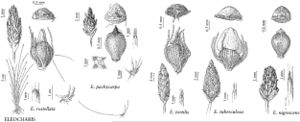Difference between revisions of "Eleocharis tuberculosa"
in J. J. Roemer et al., Syst. Veg. 2: 152. 1817.
FNA>Volume Importer |
imported>Volume Importer |
||
| (5 intermediate revisions by 2 users not shown) | |||
| Line 1: | Line 1: | ||
{{Treatment/ID | {{Treatment/ID | ||
|accepted_name=Eleocharis tuberculosa | |accepted_name=Eleocharis tuberculosa | ||
| − | |accepted_authority=(Michaux) Roemer & Schultes | + | |accepted_authority=(Michaux) Roemer & Schultes |
|publications={{Treatment/Publication | |publications={{Treatment/Publication | ||
|title=in J. J. Roemer et al., Syst. Veg. | |title=in J. J. Roemer et al., Syst. Veg. | ||
| Line 7: | Line 7: | ||
|year=1817 | |year=1817 | ||
}} | }} | ||
| − | |basionyms={{Treatment/ID/ | + | |special_status={{Treatment/ID/Special_status |
| + | |code=F | ||
| + | |label=Illustrated | ||
| + | }}{{Treatment/ID/Special_status | ||
| + | |code=E | ||
| + | |label=Endemic | ||
| + | }} | ||
| + | |basionyms={{Treatment/ID/Basionym | ||
|name=Scirpus tuberculosus | |name=Scirpus tuberculosus | ||
|authority=Michaux | |authority=Michaux | ||
| + | |rank=species | ||
| + | |publication_title=Fl. Bor.-Amer. | ||
| + | |publication_place=1: 30. 1803 | ||
}} | }} | ||
|synonyms={{Treatment/ID/Synonym | |synonyms={{Treatment/ID/Synonym | ||
|name=Eleocharis tuberculosa var. pubnicoensis | |name=Eleocharis tuberculosa var. pubnicoensis | ||
|authority=Fernald | |authority=Fernald | ||
| + | |rank=variety | ||
}} | }} | ||
|hierarchy=Cyperaceae;Eleocharis;Eleocharis subg. Eleocharis;Eleocharis sect. Eleocharis;Eleocharis (sect. Eleocharis) ser. Tenuissimae;Eleocharis tuberculosa | |hierarchy=Cyperaceae;Eleocharis;Eleocharis subg. Eleocharis;Eleocharis sect. Eleocharis;Eleocharis (sect. Eleocharis) ser. Tenuissimae;Eleocharis tuberculosa | ||
| Line 39: | Line 50: | ||
-->{{#Taxon: | -->{{#Taxon: | ||
name=Eleocharis tuberculosa | name=Eleocharis tuberculosa | ||
| − | + | |authority=(Michaux) Roemer & Schultes | |
| − | |authority=(Michaux) Roemer & Schultes | ||
|rank=species | |rank=species | ||
|parent rank=series | |parent rank=series | ||
| Line 53: | Line 63: | ||
|publication title=in J. J. Roemer et al., Syst. Veg. | |publication title=in J. J. Roemer et al., Syst. Veg. | ||
|publication year=1817 | |publication year=1817 | ||
| − | |special status= | + | |special status=Illustrated;Endemic |
| − | |source xml=https:// | + | |source xml=https://bitbucket.org/aafc-mbb/fna-data-curation/src/2e0870ddd59836b60bcf96646a41e87ea5a5943a/coarse_grained_fna_xml/V23/V23_131.xml |
|genus=Eleocharis | |genus=Eleocharis | ||
|subgenus=Eleocharis subg. Eleocharis | |subgenus=Eleocharis subg. Eleocharis | ||
Latest revision as of 20:38, 5 November 2020
Plants perennial, forming dense clumps, not stoloniferous. Rhizomes present or not, caudexlike, ascending, 1 mm thick; internodes and scales hidden by crowded culms, not evident. Culms elliptic or sometimes circular, with several rounded ridges and sulcate when dry, 15–75 cm × 0.3(–1.5) mm, firm, minutely granular at 10X. Leaves: distal leaf sheaths persistent; stramineous to green, often minutely red-spotted, papery to membranous, apex subacute to narrowly acute, often with tooth-like callus. Spikelets: basal spikelets absent; never proliferous, ovoid, terete, 5–15 × 2.5–4 mm, apex acute; proximal scale empty, deciduous, clasping 1/2 of culm, similar to floral scales; subproximal scale often empty; floral scales spiraled, 10–30, 5–6 per mm of rachilla, pale orange-brown, midribs green, broadly ovate, 2.5–4 × 1.5–2.5 mm, central area and often flanks papery to cartilaginous (or membranous), midrib evident, apex broadly rounded to obtuse. Flowers: perianth bristles 5–6, bright brown, stout, slightly shorter than to equaling tubercle; spinules rarely absent, dense, variably from divaricate to antrorse, very short, and blunt to acute, to often much longer and retrorse, sharply acute; stamens 2–3; anthers 0.5–1 mm; styles 3-fid. Achenes medium brown, obovoid to obpyriform, compressed (often obscurely) trigonous, angles evident, 0.9–1.7 × 0.8–2 mm; apex often constricted proximal to tubercle, very coarsely cancellate at 10X, each face with 8–10 longitudinal rows of large depressions. Tubercles bone-white to pale orange-brown, often red-spotted, subpyramidal, cross section plano-convex, 0.9–1.7(–2.4) × 0.7–1.2–2(–2.2) mm, at least as high and wide as achene, spongy, apex rounded, often with an abaxial acute projection.
Phenology: Fruiting spring (in south)–fall.
Habitat: Wet soil, freshwater, ponds, lakeshores, streams, meadows, pine woods, grasslands, disturbed places, bogs
Elevation: 0–500 m
Distribution

N.S., Ala., Ark., Fla., Ga., La., Mass., Miss., N.J., N.C., S.C., Tenn., Tex.
Discussion
Eleocharis tuberculosa evidently is closely related to E. tortilis, from which it differs in its larger tubercles, culms that are always elliptic in cross section, and perianth bristle spinules that are often divaricate to antrorse and often blunt. The specimens of E. tuberculosa from throughout its range which are like E. tortilis in having retrorsely spinulose perianth bristles have been named E. tuberculosa forma retrorsa Svenson (type from Massachusetts). Plants from Nova Scotia with nearly smooth bristles have been named E. tuberculosa var. pubnicoensis Fernald and E. tuberculosa forma pubnicoensis (Fernald) Svenson.
We have not seen voucher specimens for literature reports of Eleocharis tuberculosa from Connecticut, Delaware, Maine, Maryland, New Hampshire, New York, Pennsylvania, Rhode Island, or Virginia.
Selected References
None.
